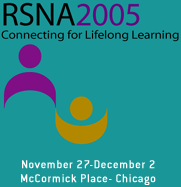
Abstract Archives of the RSNA, 2005
SSC07-01
Macromolecular Contrast Agents for Functional MRI of the Kidneys: New Insights into Pathogenesis of Renal Disease
Scientific Papers
Presented on November 28, 2005
Presented as part of SSC07: Genitourinary (Upper Tract MR Imaging)
Hisataka Kobayashi MD, PhD, Presenter: Nothing to Disclose
Satomi Kawamoto MD, Abstract Co-Author: Nothing to Disclose
James Dear MD, Abstract Co-Author: Nothing to Disclose
Martin W Brechbiel MD, Abstract Co-Author: Nothing to Disclose
Robert A Star MD, Abstract Co-Author: Nothing to Disclose
Peter L. Choyke MD, Abstract Co-Author: Nothing to Disclose
Macromolecular MRI contrast agents can provide specific functional information about the kidney. We reported that dynamic MRI with small-size dendrimer-based macromolecular contrast agents (Gd-Dendrimer) was able to diagnose the severity of acute tubular injury in cisplatin induced nephrotoxicity [Kidney Int., 2002; 61:1980]. The normal pattern of excretion of Gd-Dendrimer-based macromolecular contrast agents is by glomerular filtration where they become highly concentrated within the proximal tubule leading to a characteristic black band before they are excreted in the urine. Changes of excretion patterns of the agents would differentiate the etiologies of renal failure induced by different causes.
In this study, we employed 4 different models of acute renal failure; cis-platin nephrotoxicity (n=14; 3 different doses), ischemia (n=9; 2 duration), acute obstruction of ureter (n=4), and sepsis (n=16); with or without treatment with ethyl pyruvate and performed functional MRI of the kidney with Gd-dendrimer. Renal function tests (serum creatinine, normal: <0.3mg/dl) and renal histology were correlated with the enhancement patterns on the functional MRI.
Disappearance of the bright band in the outer stripe of the outer medulla was correlated to mild intra-renal damage based on serum creatinine (0.3-0.5 mg/dl) and histology (mild cellular damage with minimal cast formation in the tubules). No enhancement in the medulla and high enhancement in the outer cortex was correlated with severe damage in the tubules. Minimal enhancement of the entire kidney and prolonged contrast agent retention in the sepsis model were correlated to a reduction in glomerular filtration and loss of concentrating ability. Acute ureteral obstruction did not change the enhancement pattern in the renal parenchyma.
The renal injury produced alterations in the intra-renal contrast kinetics of Gd-Dendrimer, which can reflect the mechanism of injury. The enhancement pattern of functional kidney MRI with macromolecular Gd-Dendrimers can provide clues to the pathogenesis of the acute renal failure that may critically influence the choice of therapy and predict patient outcome.
Kobayashi, H,
Kawamoto, S,
Dear, J,
Brechbiel, M,
Star, R,
Choyke, P,
Macromolecular Contrast Agents for Functional MRI of the Kidneys: New Insights into Pathogenesis of Renal Disease. Radiological Society of North America 2005 Scientific Assembly and Annual Meeting, November 27 - December 2, 2005 ,Chicago IL.
http://archive.rsna.org/2005/4408598.html

